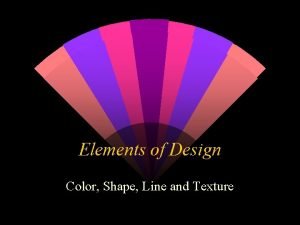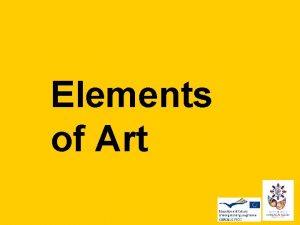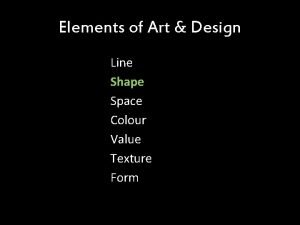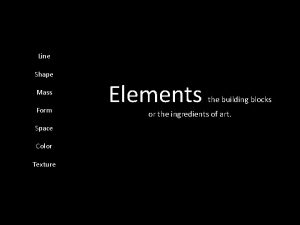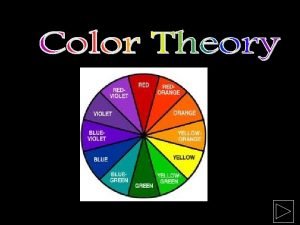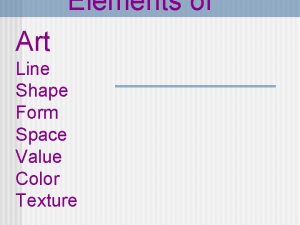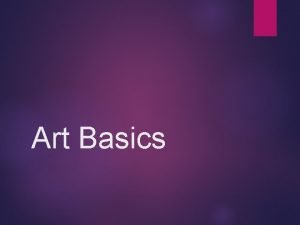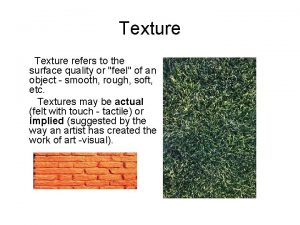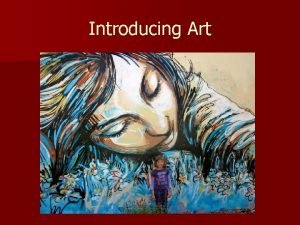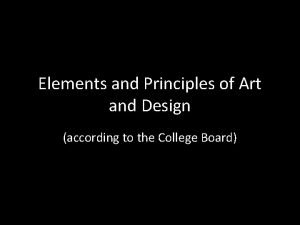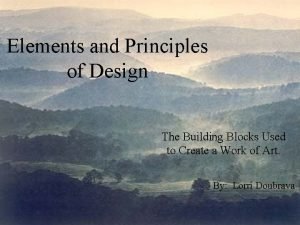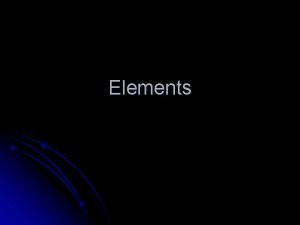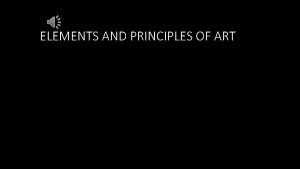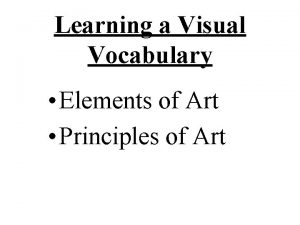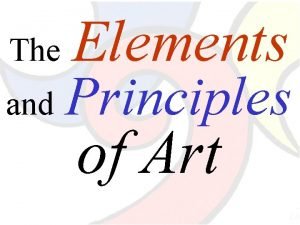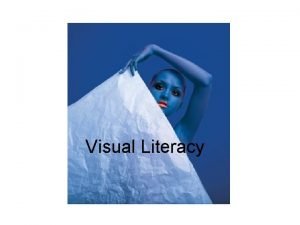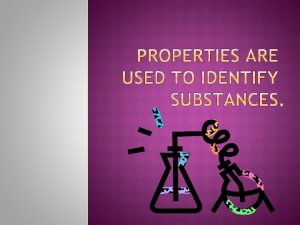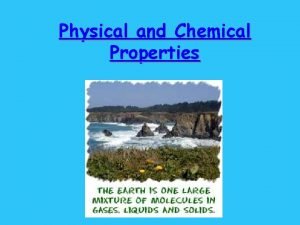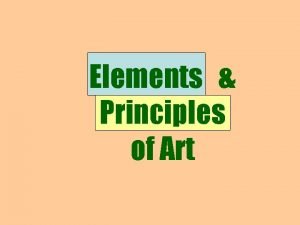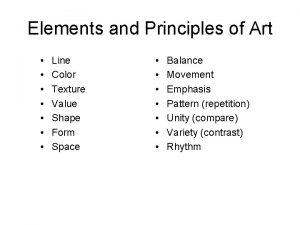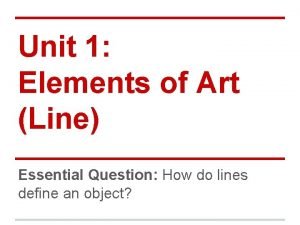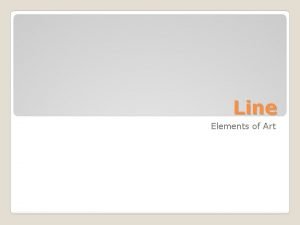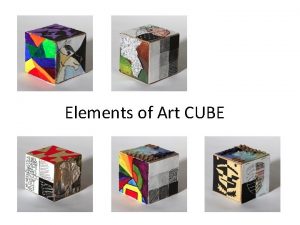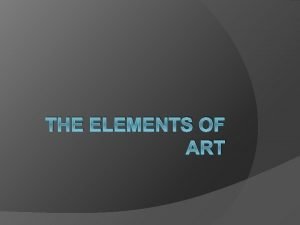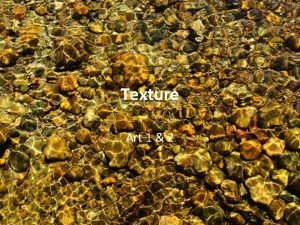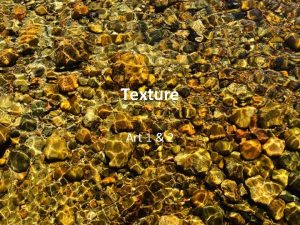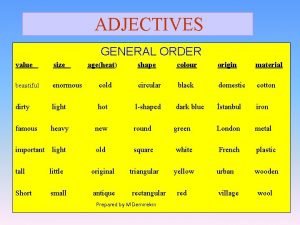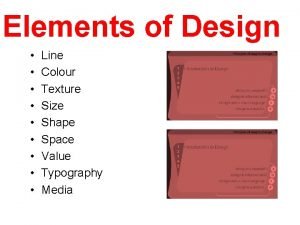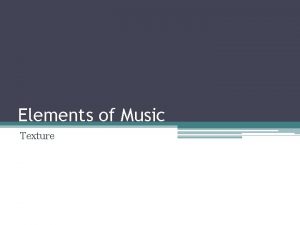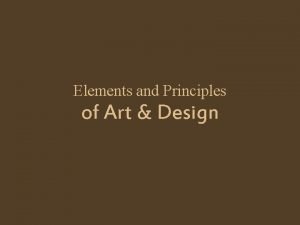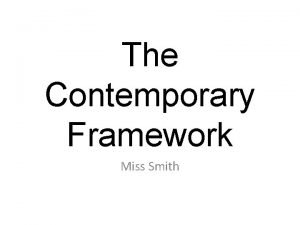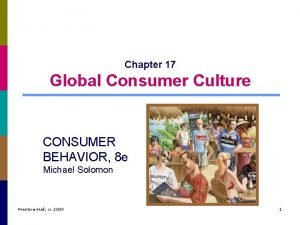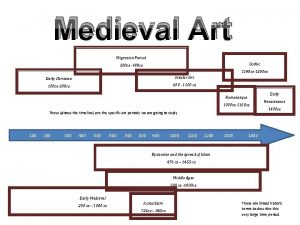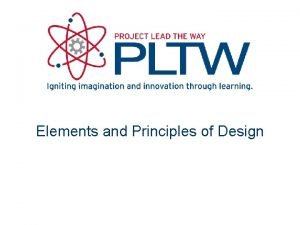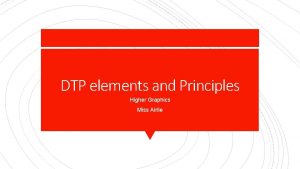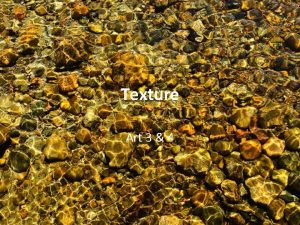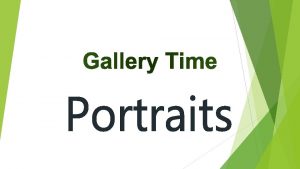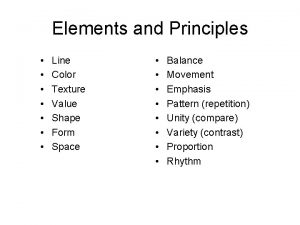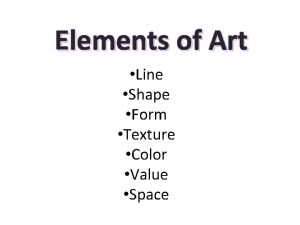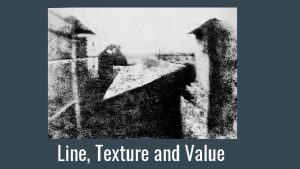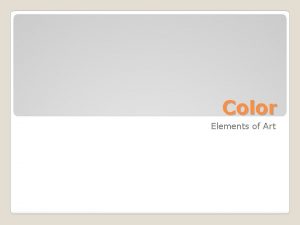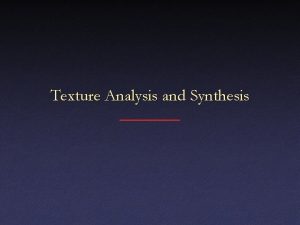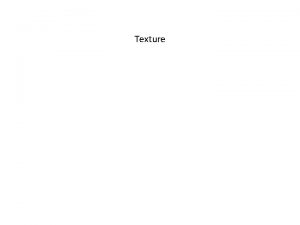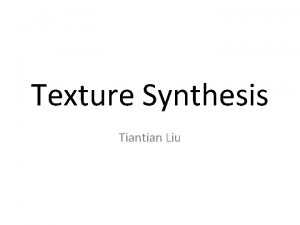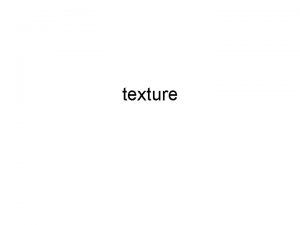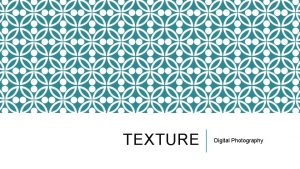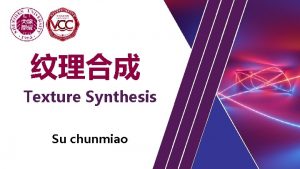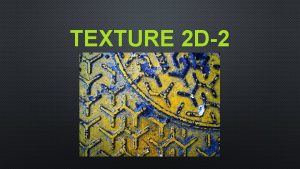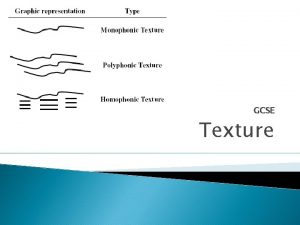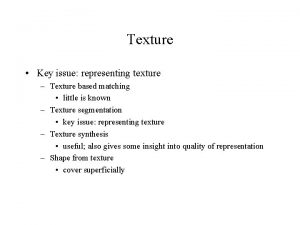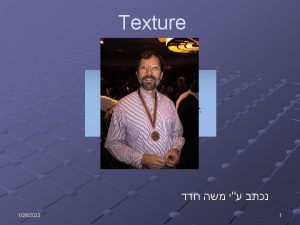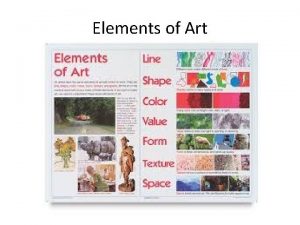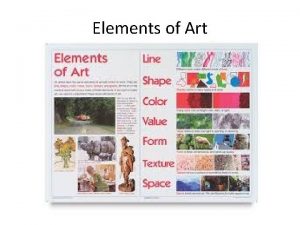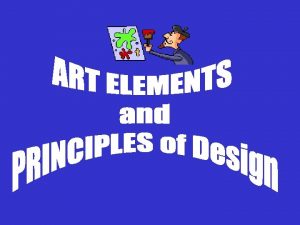Elements and Principles of Art Line Color Texture











































- Slides: 43

Elements and Principles of Art • • Line Color Texture Value Shape Form Space • • Balance Movement Emphasis Pattern (repetition) Unity (compare) Variety (contrast) Rhythm

Elements • • Line Color Texture Value Shape Form Space

Line I. a continuous mark, made by a moving point, on a surface, or in space A. Actual - Fully drawn lines or Implied - Lines that are ‘hinted’ at B. Directional Vertical – Up and down Horizontal – Side to side, like the horizon Diagonal – Any line that is not vertical or horizontal. C. Descriptive Adjectives and Adverbs

The Obvious STRAIGHT HORIZONTAL VERTICAL DIAGONAL

Barnett Newman, Dionysius, 1944, 67 x 49 in.

Barnett Newman, Yellow Painting, 1949

Note lines implied by directional gazes Diego Rivera, The Flower Carrier, 1935, 48 x 48 in.


Hokusai, Katsushika The Great Wave Off Kanagawa From "Thirty-six Views of Mount Fuji" 1823 -29 Color woodcut 10 x 15 in.

Clyfford Still, 1957, No. 1

Lines create planes; planes suggest volume THE UPSTAIRS Charles Sheeler (American, b. 1883, d. 1965) 1938 oil on canvas 19 1/2 x 12 3/4 in. (49. 5 x 32. 4 cm)

Color I. produced when light, striking an object, is reflected back to the eye. II. All hues on the color spectrum, even hues not on the spectrum such as black and white. A. Hue - the name we give to a color (red, yellow, etc. ).

B. Intensity - the strength and vividness of the color. Describe the color blue as (bright, rich, vibrant) or "dull" (grayed). C. Value-light or darkness of a color

PRIMARY & secondary RED PURPLE BLUE GREEN YELLOW ORANGE

COLOR WHEEL HUE


Robert Delaunay, Circular Forms, c. 1912

Texture Actual texture- the way something actually feels Implied texture- the way something appears to feel visually

Meret Oppenheim, Fur covered cup, saucer, and spoon, 1936 (a. k. a. The Object)

VAN GOGH, Vincent The Starry Night 1889, Oil on canvas, 29 x 36 1/4 in p. 383

Value IV. The lightness or darkness of a color. The terms shade and tint are in reference to value changes in colors A. Tint - when white is added to a pure hue B. Shade - when black is added to a pure hue C. Tone – when white AND black are added to a color


Shape A. Space that is contained within edges B. Organic-irregular – An irregular 2 D enclosed area, like that which might be found in nature. B. Geometric-has a strict pattern – 2 D enclosed area created by exact mathematical law.

Geometric Shapes:

Organic Shapes

Form A. A 3 D space B. Organic – An irregular 3 D enclosed area, like that which might be found in nature. C. Geometric – 3 D enclosed area that has a strict pattern

Organic Forms

VOLUME LINE SHAPE VOLUME Implied in painting; actual in sculpture

What is the form of this can of soup by Andy Warhol?

Space A. The appearance of depth in art B. Actual – the real distance between or around areas or components within of a piece. C. Implied/illusionary - the appearance of space or depth within a work of art. D. Positive – Solid areas or objects E. Negative – ‘air’ around solid objects, space where other things are not present


Space

Principles • • Balance Movement Emphasis Pattern (repetition) Unity (compare) Variety (contrast) Rhythm

Balance the ways in which the elements (lines, shapes, etc. ) of a piece arranged Symmetrical - elements are given equal "weight" from an imaginary line in the middle of a piece. Near symmetry- same weight…not the same stuff. Asymmetrical - occurs when elements are placed unevenly in a piece, but work together to produce harmony overall.

How is this photograph balanced? Is it symmetrical, near symmetrical, or asymmetrical?

Movement a visual flow through the composition as you move from object to object by way of placement and position Actual – an object that has true motion. Implied - the suggestion of motion in a design.

Toulouse Lautrec, Marcelle Lender Dancing the Bolero

Emphasis • What stands out in the art and what draws the viewer’s attention in.

Pattern(Repetition) the repetition of an element (or elements) in a work

Unity(Compare) • How an artworks are similar or alike or how they go together.

Variety(Contrast) • How things are different. This creates visual interest. High contrast= VERY different Low contrast= a little different

Rhythm • Rhythm, in art, is a visual beat.

Bibliography • http: //www. princetonol. com/groups/iad/Files/elements 2. htm • http: //arthistory. about. com/od/glossary/Art_History_Glossary. htm • http: //www. sculpture-painting. co. uk/art_terms. htm
 Color shape size and texture are
Color shape size and texture are Color spectrum bent into a circle
Color spectrum bent into a circle Shape space art
Shape space art Line mass color texture balance
Line mass color texture balance Polygon drawings line color value texture shape space form
Polygon drawings line color value texture shape space form Polygon drawings line color value texture shape space form
Polygon drawings line color value texture shape space form Art basics
Art basics Implied or simulated texture has tactile feel
Implied or simulated texture has tactile feel The actual surface feel of the simulated appearance
The actual surface feel of the simulated appearance A feeling of visual equality in shape, form, value, color
A feeling of visual equality in shape, form, value, color Elements and principles of art
Elements and principles of art Principle of variety
Principle of variety Value rhythm art
Value rhythm art Basic elements of musical play/theatre
Basic elements of musical play/theatre Analysis of painting
Analysis of painting 7 principles of art
7 principles of art Gaze demand and offer
Gaze demand and offer Texture physical property
Texture physical property Hardness texture color and freezing point are examples of
Hardness texture color and freezing point are examples of Elements principles of art
Elements principles of art Elements principles of art
Elements principles of art Principles of art line
Principles of art line Elements of art: color
Elements of art: color Varied line
Varied line Elements of art line examples
Elements of art line examples Elements of art line example
Elements of art line example Art elements line
Art elements line Texture vocabulary
Texture vocabulary Actual texture
Actual texture A plain scale of 1 cm=5m and show on it 37m
A plain scale of 1 cm=5m and show on it 37m Size shape age color
Size shape age color Size shape color texture
Size shape color texture Texture in music meaning
Texture in music meaning Element and principles of art
Element and principles of art High art vs low art
High art vs low art Cultural formulae
Cultural formulae What is the purpose of a flying buttress?
What is the purpose of a flying buttress? 7 principles of hair design
7 principles of hair design List the five elements of hair design
List the five elements of hair design Proximity floral design
Proximity floral design Elements and principles of design chart
Elements and principles of design chart Elements of interior design ppt
Elements of interior design ppt This line represents calm, peace, and relaxation.
This line represents calm, peace, and relaxation. Connesct
Connesct
